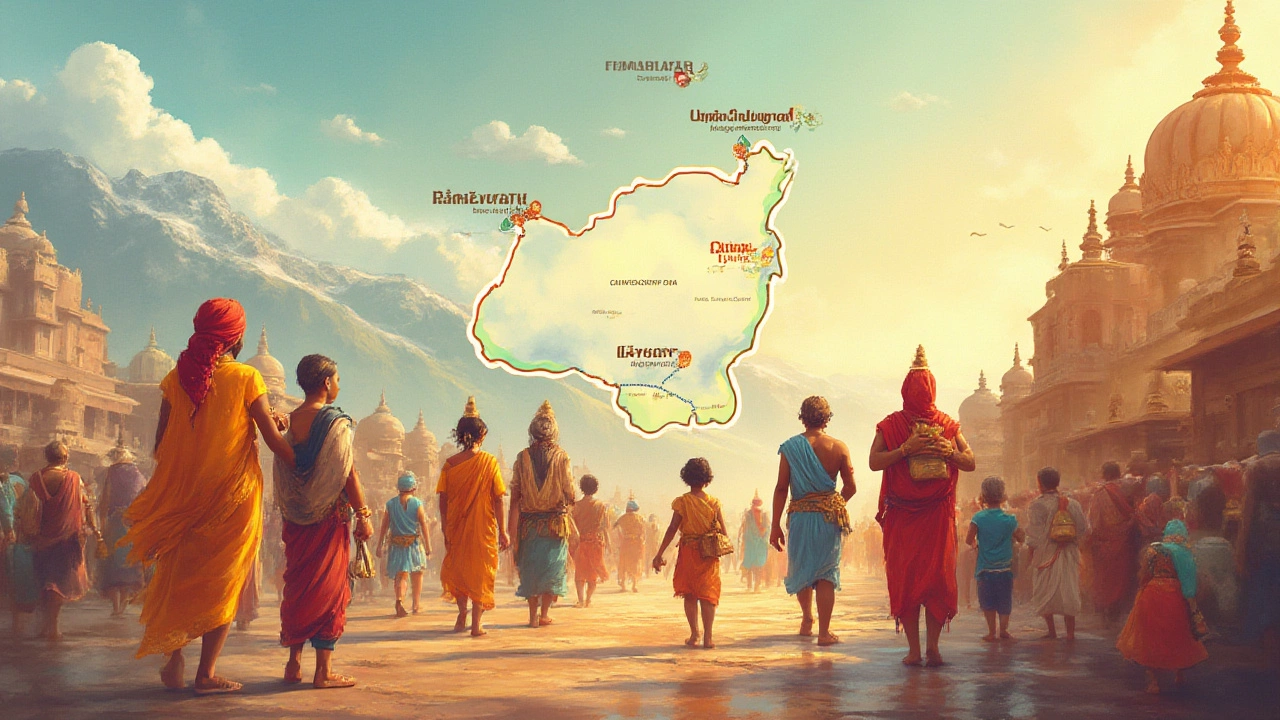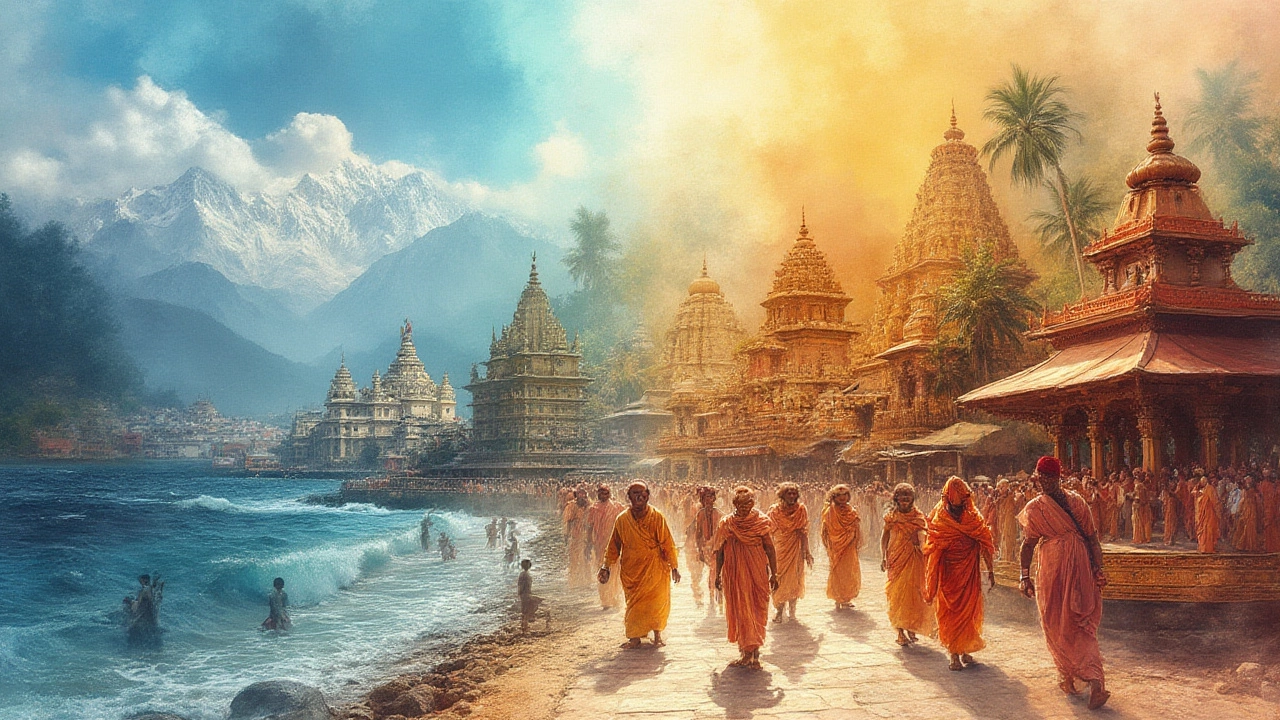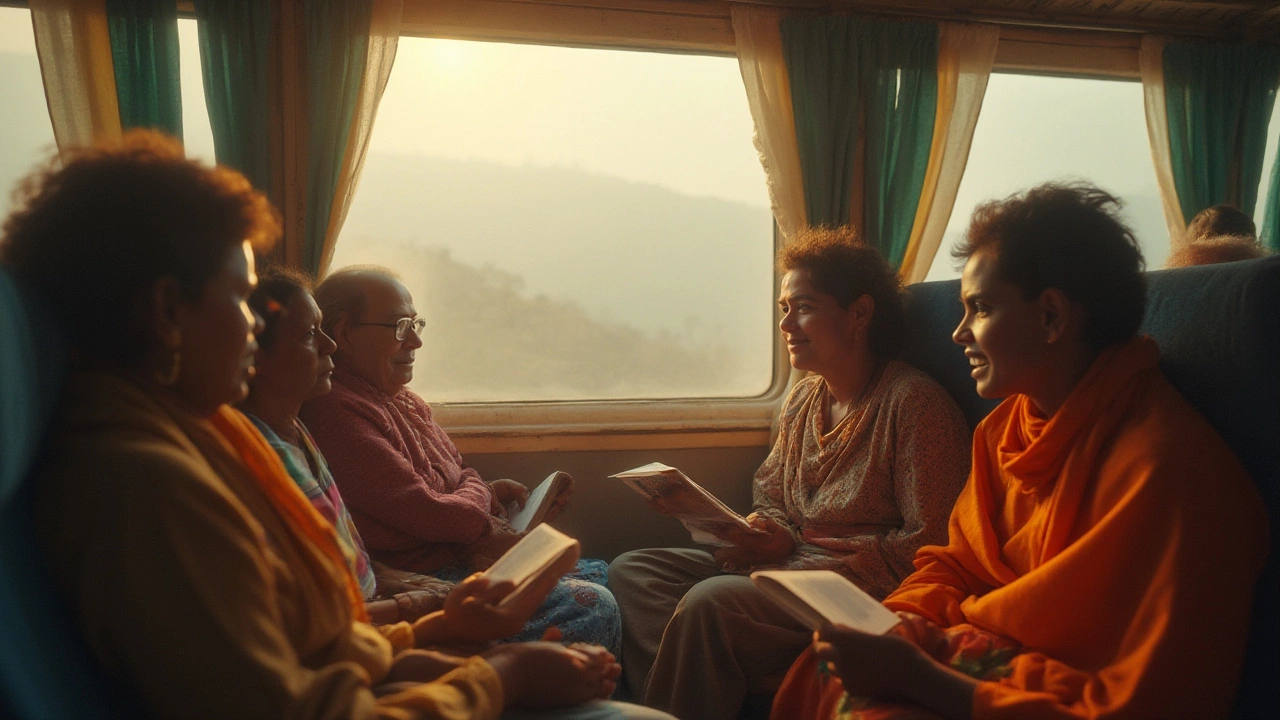4 Dham in India: Discover Char Dham Pilgrimage, Meaning, Routes & Spiritual Facts
 Jul, 8 2025
Jul, 8 2025
The idea that a journey can cleanse you from lifetimes of bad karma is powerful—maybe that's why people travel thousands of miles, braving steep trails, heat, or even snow, all just to touch the earth at four legendary spots: the Char Dham. These sites aren’t just typical tourist stops. They've shaped centuries of pilgrimage, family stories, and even local economies in the far ends of the country. Imagine planning a trip where the route itself is seen as a blessing—where sometimes the destination is so challenging that reaching it becomes a story for grandchildren. Every year, millions set out, hoping for transformation, adventure, and maybe a miracle or two. The Char Dham is more than a checklist for the devout; it’s a physical and spiritual map of India, stretching from the icy north to the balmy south, from windswept coasts to mighty rivers. If you’ve wondered what binds these four places, how to get there, or why they stir so much emotion—let’s unravel what makes the Char Dham Yatra iconic.
What is the Char Dham? The Heart of Hindu Pilgrimage
Hidden beneath all the stories, the word “Dham” roughly means an abode or a sacred place. Now, take four such places—Badrinath, Dwarka, Puri, and Rameswaram—dot them on a map, and you’ve got the legendary Char Dham circuit. The sage Adi Shankaracharya, back in the 8th century CE, is said to have chosen these spots as the holiest for a reason. Each Dham sits in a corner of the subcontinent, pulling pilgrims across miles of diverse landscapes, almost like a spiritual compass for Hindus. The trip promises cleansing of sins and spiritual upliftment, but for a lot of people, it's just as much about conquering personal challenges or spending days on buses and trains making memories with family or friends.
Each Dham is dedicated to a different deity: Badrinath honors Lord Vishnu, Dwarka also centers on Vishnu in his Krishna avatar, Puri is home to Lord Jagannath (another form of Krishna), and Rameswaram celebrates Lord Shiva. There’s a sense of balance in that—Vishnu and Shiva representing two sides of divinity. Fun fact: most families I know in India can list off the Dhams faster than their cousins’ names. This isn’t just about faith. It’s history, geography, and sometimes, oddly, bragging rights. For instance, there’s data showing that the Char Dham pilgrimage can draw up to 3–4 million travelers a year for the Himalayan leg alone. Some travelers treat these trips as once-in-a-lifetime adventures—while others make it a regular goal with parents or partners.
You’ll hear people mention ‘Char Dham Yatra’ and ‘Chota Char Dham Yatra’—don’t mix them up. The Chota Char Dham happens mostly in Uttarakhand (Yamunotri, Gangotri, Kedarnath, Badrinath), while the main Char Dham stretches across the full length and breadth of the country. Planning tips: whether you want to book through official tour operators, hop on local buses, or even go on foot, triple-checking routes and weather isn’t an exaggeration—especially in the north during monsoon or winter. Some highways and trails get covered in snow or get washed out. And if you’re like my wife, Lucy, who needs a daily fix of filter coffee, pack accordingly. Rural spots can be a little rough on comforts.
Badrinath: Northern Sanctuary in the Himalayas
If you ever pictured a temple practically hanging off a hillside, with snow-capped mountains in every postcard shot—welcome to Badrinath. Located in the Garhwal hills of Uttarakhand, this Dham sits at roughly 3,300 meters above sea level, with the icy Alaknanda River rushing just nearby. The journey here is anything but boring—winding roads, unpredictable weather, and at times, herds of goats blocking your SUV. Badrinath is dedicated to Lord Vishnu, specifically his avatar, Badrinarayan, and has roots stretching back over a thousand years. It’s said Adi Shankaracharya himself established the shrine here, pulling together myths and traditions that dated back centuries.
One cool detail: every year, the temple closes for about six months due to heavy snowfall. The head priest, a Namboodiri Brahmin from Kerala (far south!), locks the doors and leaves—with rituals promising that divinity continues in absence. When spring thaws and the gates open, the countryside erupts in wildflowers and sudden crowds. Badrinath isn’t just a single destination—you’ll find sacred hot water springs called Tapt Kund nearby, pilgrim guesthouses, and food stalls serving piping-hot rajma-chawal to shivering visitors. Legends swirl here, tying the temple to ancient sages who meditated in caves, and to legends about Lord Narayana sitting in meditation under a massive Badri tree (a kind of wild berry).
Getting here still demands patience. The typical route winds via Haridwar or Rishikesh, climbing through towns like Joshimath before a jaw-dropping final ascent. Roadblocks after landslides aren’t rare, so check conditions and weather advisories constantly. The best time for the journey is usually late April to early November, after which Badrinath hides under snow. Handy tip: altitude sickness is real! Hydration, gradual ascent, and taking iodine-rich snacks (often sold en route) help avoid headaches and breathlessness. Families with older adults or kids should be careful and speak with local doctors if unsure. Few other pilgrimage sites in India feel as remote or “earned” as Badrinath—there’s a sense that just making it there is half the blessing.

Dwarka: The Western Edge, City of Lord Krishna
Now picture this: a temple that juts into the Arabian Sea, surrounded by gulls, salt breeze, and the gentle chaos of an old port city—you’re in Dwarka, Gujarat. Dwarka means 'doorway,’ and legend says it literally was the entrance to Krishna’s glorious kingdom. Some stories say the original city was swallowed by the sea, and scuba divers exploring just offshore claim to find traces of old ruins. For Hindus, Dwarka is as much about myth as it is about astonishing geography.
The Dwarkadhish Temple dominates the city—a five-story stone marvel, topped by a 52-yard flag, which is replaced five times a day, sometimes in wild winds! The vibe is lively: conch shells blown for prayer, temple elephants, boatmen steering pilgrims to the tiny island of Bet Dwarka (said to be Krishna’s real residence). A unique tradition: priests here are descendants of original serving priests, maintaining rituals unchanged for centuries. If you’re lucky, you might see married couples seeking blessings for children or families celebrating after a child’s first steps—temples are woven into every life event here.
Travelers usually reach Dwarka by train or car from Ahmedabad—about 450 kilometers away. Visiting during Janmashtami (Krishna’s birthday) feels like joining half the city in a riot of music, food, and dazzling lights. If you want to hit the full circuit, catch a ferry out to Okha and Bet Dwarka for more shrines and stunning sea views. The temple is busiest from October to March when the weather is pleasant. Handy packing tips: hats for the sun, a scarf for dust, and a readiness for coastal salt in your hair. If you’re a history buff, bug a local guide about the recent marine archaeology expeditions—they’ll tell you how some believe Dwarka really is one of the oldest port cities in the world. And if you have a sweet tooth, don't miss local prasad—Dwarka’s laddoos have a fanbase for a reason.
Puri: Divine Beaches and Jagannath Mysteries
Hot sand, wide beaches, and a sea breeze that never gives up—Puri, on India’s east coast, is a totally different Dham experience. The gigantic Jagannath Temple, with its thick walls and massive towers, dominates the skyline. What’s wild about Puri is that you’re basically walking into a living, breathing festival—the city never really slows down, with parades, processions, and constant chanting. Lord Jagannath (meaning “Lord of the Universe”) is worshipped here with his siblings Balabhadra and Subhadra—a unique family combo not seen at any other major South Asian temple.
The annual Rath Yatra is the main event—giant wooden chariots get dragged by devoted crowds, some even risking injury to grab the ropes for a shot at salvation. Stats show that this single festival can bring up to a million people to Puri in a single week, turning the city into a sea of colors, music, and motion. There’s a famous kitchen inside the temple—the largest in the world—that can feed 100,000 pilgrims daily, using wood-fired hearths and age-old recipes. Nobody leaves hungry at Jagannath. Yet, strict temple rules—especially regarding entry—mean that only Hindus can walk into the main sanctum; non-Hindus can still admire the ancient architecture from outside or climb atop the nearby library for a sweeping view.
Getting to Puri’s easy via flights to Bhubaneswar and a quick local train. The best seasons are winter and early summer, just before the monsoon. Once here, it’s easy to pair a pilgrimage with downtime on the beach or a wander through the city’s bustling craft markets. Local tip: try the temple’s mahaprasad (sacred food) served on leaf plates—you’ll eat like a king for less than a dollar. Don’t forget sunblock, and be ready for sudden showers year-round. Puri’s legends dive deep: every century, the main deities' wooden idols are replaced in a secret overnight ceremony. If you like your spirituality with a side of ocean and spicy snacks, Puri is hard to top.

Rameswaram: Southern Sacredness on Adam’s Bridge
Few places hit you with as much atmosphere as Rameswaram—sitting at the very tip of Tamil Nadu, connected almost by accident to Sri Lanka via a chain of tiny islets and sandbars known as Adam’s Bridge or Rama Setu. This Dham is devoted to Lord Shiva and is loaded with links to the epic Ramayana. Locals will tell you this is where Rama built a bridge to rescue Sita from the demon-king Ravana—a tale recounted so often that it feels almost real as you walk the windswept shores.
The Ramanathaswamy Temple is a maze of pillared corridors and glimmering oil lamps, famous for having the longest corridor in any Hindu temple—fans of strange architecture will love how shadows shift on the ancient floors. Devotees bathe in a series of 22 sacred wells before heading to the main shrine—each well has water with a different taste or temperature, and there’s a whole art to pouring, blessing, and moving on. Pilgrims see Rameswaram as the perfect fusion of Vishnu (in the form of Rama) and Shiva, who was worshiped here with lingams made of sand and later more permanent stone.
Travel is easiest by train or car from Madurai, or even by flying to the nearest airport. The road crosses the spectacular Pamban Bridge, where you can watch fishing boats cut through clear blue water below. The best time for your visit: winter (November to March) when the heat is manageable and sea breezes keep things cool. If you crave a classic South Indian breakfast after your dip, food stalls outside the temple will hook you up with hot idlis and coconut chutney. Travelers love to take a detour to Dhanushkodi—the abandoned “ghost town” at the island’s edge, where you literally drive to where land runs out. Remember: Rameswaram marks the southernmost tip of the Char Dham, and is seen as a place where sins are shed and cycles reset.
| Dham | Main Deity | State | Best Visiting Season | Unique Attraction |
|---|---|---|---|---|
| Badrinath | Vishnu (Badrinarayan) | Uttarakhand | May–November | Tapt Kund hot springs, Himalayas |
| Dwarka | Krishna (Dwarkadhish) | Gujarat | October–March | Sea coast, Dwarkadhish temple |
| Puri | Jagannath (Krishna) | Odisha | November–March | Rath Yatra, largest kitchen |
| Rameswaram | Shiva | Tamil Nadu | November–March | Pamban bridge, sacred wells |
Each char dham holds its own personality, challenges, and sense of magic. Whether your motivation is faith, curiosity, or wanderlust, the Char Dham Yatra offers a panorama of Indian tradition and physical landscapes you just can’t get anywhere else. If you decide to make the trip yourself (or like Lucy, just soak up temple vibes from the photos), each stop is a reminder that the journey shapes you at least as much as the destination. Prepare for a little discomfort, a lot of chaos, and scenes you’ll be talking about at family dinners for years.